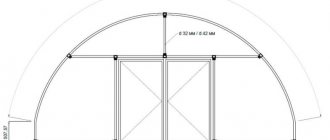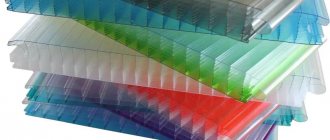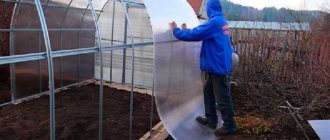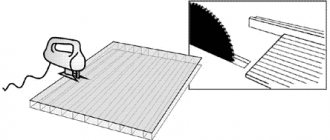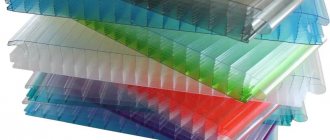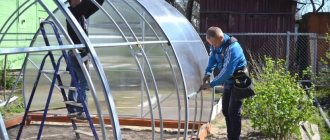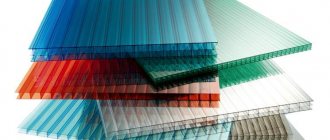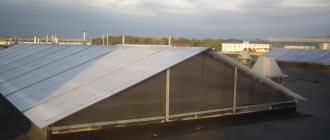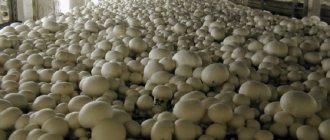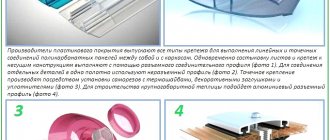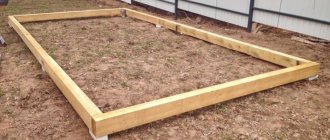Polycarbonate is ideal for creating lightweight translucent structures. In private construction, honeycomb panels and monolithic material are actively used; with their help, greenhouses and fences are erected, roofs of gazebos and canopies are installed. Let's look at how polycarbonate is attached to a metal frame and what principles are used to select hardware for installation.
Greenhouse made of cellular polycarbonate Source kinplast.ru
Self-tapping screws for installing polycarbonate
To prevent damage to the polycarbonate during installation and during operation of the finished structure, special fasteners are used. Self-tapping screws for polycarbonate are equipped with a gasket and a sealing washer.
Each fastener component performs a specific function:
- the self-tapping screw passes through a hole in the polycarbonate and is securely fixed in a metal or wooden frame, its task is to hold the sheet covering of the structure;
- The sealing washer allows you to increase the contact area so that the head of the fastening element does not damage the material during installation and under operating loads, and ensure a tight fit of the sheet to the frame;
- The gasket serves to seal the attachment point.
Dimensions of fasteners
Self-tapping screws are selected taking into account the diameter of the thermal washer, which in the standard version is 5-8 mm. Thermal washers with a diameter of more than 8 mm are used less frequently. Without this fastener component, polycarbonate cannot be installed.
Washers for polycarbonate Source wixstatic.com
The most common diameters of fasteners are 4.8 and 5.5 mm. Products with a smaller diameter are not strong enough, and larger self-tapping screws do not fit into the holes of standard thermal washers.
The length of the hardware is selected taking into account the total thickness of the sheet material, the height of the washer and the thickness of the frame elements - the self-tapping screw must enter the structure to a depth sufficient for reliable fastening, but not go through. Fastening polycarbonate to the metal frame of the greenhouse and other metal structures is usually done with hardware 30-40 mm long. To fix thick honeycomb sheet material to wooden frames, self-tapping screws longer than 50 mm may be required.
Hardware caps
Self-tapping screws suitable for installing polycarbonate panels differ in the design of the head. She may have:
- slot for a cross bit PZ or Ph (the most popular option);
- edges for an open-end wrench or head (in some cases, in addition to the edges, there is a slot for a bit);
- hex key hole
A self-tapping screw with a head for an open-end wrench Source stroyfora.ru
The choice of the type of fastening elements is the responsibility of the polycarbonate installation contractor, since the heads of the hardware must correspond to the tool at his disposal. Regardless of the type of cap, hardware equipped with thermal washers ensures that the panels are tightly pressed to the base.
Self-tapping screws for metal
Fasteners for polycarbonate to a metal frame are hardware with a wide head, which are characterized by:
- a special shape of the tip - it is not sharp, but has the shape of a drill, which makes it possible to screw a self-tapping screw into elements of metal structures without first drilling mounting holes;
- increased reliability - stronger steel is used for their production compared to hardware for wood;
- the presence of a zinc coating , which protects the metal from corrosion.
Metal screws Source polimerinfo.com
Wood screws
Self-tapping screws for polycarbonate for wood are any hardware that is suitable in diameter for the thermal washer and has a sufficient length. The screws are tightly fixed in the wood, and during the operation of the structure, the fasteners of the translucent cladding do not need to be adjusted.
Self-tapping screws for wood Source stroimaterials.ru
Other types of fasteners
It is allowed to mount polycarbonate sheets on a metal base using roofing screws with a press washer, bolts and nuts, and rivets. The choice depends on the design features. In the case of bolts and rivets, be sure to install thermal washers, which will protect the panels from cracking when the fasteners are overtightened, and will eliminate play in the translucent cladding due to loose fixation.
Thermal washers
The thermal washer includes:
- washer with a through hole for the fastening element;
- a cover made of the same material, which snaps tightly and serves to protect the screw head from external influences;
- elastic seal.
Manufacturers produce self-tapping screws of standard sizes complete with thermal washers especially for the installation of polycarbonate. To fasten thick honeycomb panels, thermal washers of a special shape are used - with a leg. Such elements are deeply recessed into the panel and contribute to a more uniform distribution of the load from the fastening, which increases the reliability of fixation of the translucent coating.
Thermal washers with a leg Source stpulscen.ru
Manufacturing materials
Polycarbonate thermal washers are made from the same material as the panels, in the same colors and shades. These are washers with a wide leg and a seal in the form of a ring made of elastic polymer. This type of thermal washers is designed for 20 years of service.
Polypropylene washers are equipped with a porous plastic seal. Such thermal washers are inferior in strength and durability to polycarbonate ones. When exposed to UV radiation, they quickly lose color and become brittle. Polypropylene thermal washers are suitable for installing translucent structures indoors or outdoors in the shade.
Metal washers are made of galvanized or stainless steel. They differ in design from polymer ones - the washer itself has a concave shape, and there is no plug provided. The umbrella-shaped seal is made of plastic, polyurethane foam or EMDP rubber. Such washers are designed for mounting polycarbonate on large metal structures. Self-tapping screws and bolts are used for fastening.
Galvanized washers for fastening polycarbonate Source ergostil.ru
Advantages of using thermal washers
The complete set of fastening elements with thermal washers allows you to:
- Increase the reliability of polymer glazing . Polycarbonate is a material prone to temperature deformation. By installing a thermal washer with an elastic seal, it is possible to provide a sufficient gap between the self-tapping screw and the edges of the hole for it drilled in polycarbonate. As a result, the fastener does not interfere with the expansion of the material, and no damage or changes in the geometry of the coating occur.
- Provide thermal protection for the room . Attaching polycarbonate to a greenhouse, greenhouse or winter garden glazing frame requires a special approach: it is necessary to prevent the entry of cold air from the street. Thermal washers successfully protect the installation sites of fasteners from blowing.
- Prevent corrosion of hardware . The screw caps are covered with a thermal washer cover, and the working part of the hardware is protected from contact with moisture by an elastic seal.
Thanks to the wide range of colors, polymer thermal washers can be easily matched to the color of polycarbonate. This gives the finished translucent coating a finished look.
Washer to match the color of the sheet material Source stroyfora.ru
General classification and technical characteristics
The connecting strip for polycarbonate can be classified according to the following characteristics:
- manufacturing material - polycarbonate and aluminum;
- purpose - guides, connecting, joining elements, end, ridge, wall profiles, clamping strips, etc.;
- type of connection - detachable, permanent, sliding;
- connection angle - straight and angular, with variable geometry.
Technical characteristics important for the consumer include:
- length - profiles for longitudinal sides are usually made up to 6 m, end modifications are 210 cm;
- the thickness of the panels for which the profile is intended is from 4 to 32 mm.
All connection profiles for polycarbonate have sufficient flexibility to be installed with sheets of the appropriate thickness and within the permissible bending circles.
Profiles for polycarbonate installation
Special additional elements made of polycarbonate or aluminum simplify the installation of panels, make polymer glazing more aesthetically pleasing, and extend its service life. Profiles for installation vary in design, functionality, size and color. The choice depends on the characteristics of the glazed frame and the thickness of the polycarbonate. The standard length of longitudinal profile elements is 6 meters, transverse - 2.1 meters.
UP profile
The end profile for polycarbonate panels is U-shaped. With its help, the end cuts are protected from the penetration of dirt and insects into the cavities, and they give the structure a complete appearance. The profile is placed on the pre-sealed end of the sheet. There is a trench inside the U-shaped element to drain condensate.
End profile Source tildacdn.com
HP profile
One of the types of connecting profile is a one-piece element for joining sheets of cellular or monolithic polycarbonate when creating coatings on planes and arched supports. The joining profile hermetically connects the sheets; through the jumper chamber, you can secure the element to the frame using a self-tapping screw with a thermal washer or a roofing screw with a press washer.
One-piece connecting profile Source allegroimg.com
HCP profile
Detachable connecting element consisting of a base and a cover. Its use simplifies and speeds up installation and ensures reliable joining of panels. The base part is rigidly attached to the base with self-tapping screws, and the lid snaps into place after laying the polycarbonate sheets.
Detachable connecting profile Source baza-polimerov.ru
RP profile
The ridge element makes it possible to connect panels of monolithic or cellular polycarbonate at the required angle, which can be changed during the installation process. The ridge profile includes two end extensions, which are connected to each other using a flexible joint. This element ensures the tightness of the ridge part of the translucent roof.
Ridge profile Source Teplica24.rf
FR profile
Corner profiles vary in configuration - depending on the design, it ensures reliable joining of panels at an angle of 45°, 60°, 90°, 120°. Corner connecting elements are characterized by increased rigidity and resistance to torsional loads. This profile allows you to seal corner joints of polycarbonate structures.
Angle profile 90° Source stpulscen.ru
FP profile
The wall profile is used for installing hermetically sealed connections between polycarbonate structures and vertical surfaces made of wood, metal, brick, building blocks, and cast-in-place concrete. The additional element allows you to organize an adjoining unit and at the same time performs the function of a starting end profile.
Wall (starting) profile Source dorra.by
Sealing tape
Using aluminum sealing tape, the ends of cellular polycarbonate panels are insulated when installing a translucent coating. They differ in type and purpose:
- Solid tape . With its help, the upper end of panels on pitched roofs and vertical structures is completely sealed.
- Perforated tape . Used to protect the lower ends of cellular polycarbonate coating elements. It prevents insects from entering the cavity, but does not interfere with air microcirculation, which minimizes the risk of condensation.
Aluminum tape is glued to the ends of cellular polycarbonate sheets before installation.
Features of installation of cellular polycarbonate
Structural panels, unlike monolithic polycarbonate, have stiffening ribs. To create curved surfaces, including arched structures, the panels are bent so that the ends with open cells are located in the horizontal plane. When installing pitched roofs and vertical glazing, sheets of cellular polycarbonate are oriented in the same way so that condensate flows freely from the cells.
Before attaching polycarbonate, it is necessary to protect the edges of the panels. A solid aluminum tape is glued to the upper end with open cells, and a perforated one to the lower end. In arched systems, both ends are covered with perforated tape.
During installation, translucent panels are laid upward with the side that has a special marking - it is equipped with a coating that protects the polymer material from ultraviolet radiation. Only in this case will the polycarbonate last the period stated by the manufacturer.
Quick navigation through instructions
- Installation instructions for cellular polycarbonate
- Installation of panels
- Cutting panels
- Sealing
- Panel bending
- Installation of load-bearing longitudinal frame supports
- Methods for installing cellular polycarbonate
- Holes for fastening sheets
- Application of polycarbonate profiles
- Transportation of cellular polycarbonate
- Instructions for transportation, installation and storage of “Transparent slate PLASTILUX MP-20 (U)”
- The distance between the transverse supports of structures made of profiled monolithic polycarbonate
Video description
Bending radius of polycarbonate for cladding arched structures
Fastening polycarbonate can be done in different ways (point method or in profile), but the final step is always to remove the protective film on both sides of the sheet. Before installation, it is removed only around the perimeter to avoid accidental damage to the surface. Upon completion of glazing work on a greenhouse or other structure, the film is completely removed. Otherwise, due to atmospheric influences, it will stick tightly to the surface, and after a while it will be very difficult to remove.
Cutting panels
Polycarbonate and profiles made from this material are easy to cut. We recommend using a high-quality circular saw with a stop that has a carbide blade. Be sure to maintain profile panels. This is necessary in order to avoid vibration. Before cutting polycarbonate, make sure the markings are correct.
When finished cutting, remove wood shavings from each profile cavity.
Installation using the point connection method
Polycarbonate sheets are usually attached to metal structures using the point joint method. To do this, self-tapping screws for polycarbonate for metal are used, which are screwed along the entire length of the vertical and horizontal frame elements.
At the preparation stage, marking of attachment points is carried out in increments of 25-70 cm, depending on the loads. If we are talking about how to screw polycarbonate onto a greenhouse, the standard spacing of the fastening points is 30-40 cm. If necessary, holes are pre-drilled in the frame to simplify screwing in the fasteners.
Location of fasteners Source rusolymp.ru
Stages of work:
- In polycarbonate sheets, cut to size, holes are drilled at the attachment points, the diameter of which must correspond to the diameter of the hole in the thermal washer. There must be a gap between the hardware and the edges of the hole for thermal expansion.
- A polycarbonate sheet with protected tori and protective film removed from the edges is laid on the frame. The overhang should not be more than 10 cm.
- The sheets are joined on the frame elements. If their width is not sufficient, the panels are laid overlapping and secured with longer self-tapping screws.
- When installing fasteners, the self-tapping screw is screwed in so that the thermal washer tightly presses the panel to the frame, and no dent is formed at the fastening point.
- Upon completion of installation of the casing, check all fastening points, if necessary, adjust the position of the screws and snap the thermal washer covers.
Selecting canopy material
The main thing you need to pay attention to when purchasing this product is its thickness. The durability of the future structure depends on this characteristic. Before laying polycarbonate, you should purchase sheets of 4 mm thickness for canopies and greenhouses; for greenhouses - 8 mm, for vertically located surfaces - 10 mm and for roofs of buildings - 16 mm.
In any case, before laying polycarbonate, wind and snow loads are calculated.
Installation on a metal frame using a profile
The metal structure is checked for accuracy of assembly. All elements on which the translucent coating will rest must lie in the same plane, otherwise it will be impossible to achieve a reliable fit of the panels and uniform distribution of operational loads. The installation pitch of the rafters must correspond to the width of the panels so that all joints fall on the supporting elements of the frame.
The procedure for attaching cellular polycarbonate to a metal base:
- Thermal insulating tape is laid on rafters made of metal. In this case, profile fasteners for polycarbonate are less prone to temperature deformation.
- Using metal screws, the base part of the split profile is attached to the rafters.
- Structural panels prepared for installation are placed in the resulting cells, after which the covers of the connecting elements are snapped into place.
- An end profile is placed on the lower edge of the structure.
This is a general description of the work; specific details depend on the characteristics of the glazed structure. Additionally, you may need to use ridge or corner elements or a wall profile. Fastening polycarbonate to a wooden frame using a connecting profile is carried out using the same technology, but wood screws are used.
Briefly about the main thing
The polycarbonate mount is selected depending on the frame material. Metal structures require special metal hardware.
Installation sites for fasteners require protection if the structure is operated outdoors. To do this, use self-tapping screws with thermal washers or roofing hardware with press washers.
Installation of monolithic and honeycomb panels can be carried out using the point method and using special profiles. The second option is preferable for complex structures with high requirements for appearance. Point fasteners are suitable for assembling the greenhouse.
High demands are placed on point fastening: the self-tapping screw should not be over-tightened, otherwise the polycarbonate will begin to collapse in this place under loads.
The panels are mounted upwards with the side protected from exposure to UV radiation from the sun. The protective film must be removed immediately after installation.
Varieties
It is possible to join polycarbonate sheets using special profiles:
- One-piece;
- Detachable;
- Corner products.
Aluminum connecting profile for polycarbonate, as well as products made from polymer material, are the most important components when cladding structures.
Of course, profiles alone will not do; you will need self-tapping screws and thermal washers. But then, there is no need for any special tool.
It is enough to have a screwdriver, but this is a last resort, and you can carry out installation work with a screwdriver with a suitable bit. For cutting you will need a saw with a fine tooth; for the accompanying work you can get by with the tools available on the farm.

